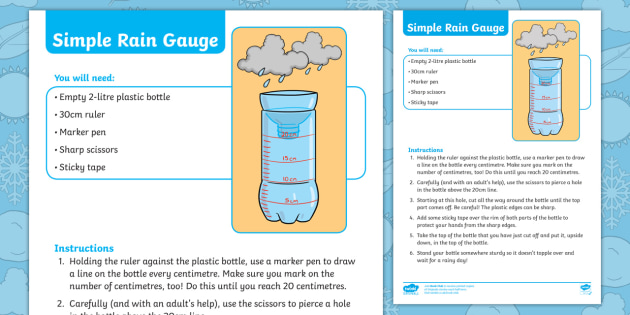Unveiling the Scientific Research Behind Rainfall Evaluates: How These Instruments Play an Important Role in Climate Research Study and Environmental Monitoring
Rain assesses, apparently simple gadgets, hold an extensive significance in the world of climate study and ecological surveillance. These unassuming tools quietly collect one of nature's most crucial components-- rainfall. Behind their plain exterior exists a complex science that is indispensable for recognizing the characteristics of our atmosphere. As we peel back the layers of this clinical shroud surrounding rainfall evaluates, we discover a globe where accuracy, information accuracy, and precise observation assemble to introduce a much deeper understanding of our changing climate and its effect on the world.
Significance of Rainfall Scales
Rainfall gauges play a vital function in surveillance and determining rainfall levels, providing essential data for environment research study and evaluation. These devices are fundamental in quantifying the amount of rains that occurs in a certain location over a specific period. By gauging and collecting rain, rainfall determines deal important understandings into the circulation and intensity of precipitation, helping meteorologists, hydrologists, and climatologists in comprehending climate patterns and patterns.
In addition, long-lasting information collected from rainfall evaluates aids in evaluating environment adjustment influences and patterns, contributing significantly to scientific study and decision-making procedures. In essence, rain gauges offer as essential devices in the area of meteorology and environmental scientific research, playing a critical role in progressing our understanding of weather condition and environment dynamics.
Kinds Of Rain Scales

Functionality and Operation
In the world of environment research study and meteorological research studies, the effectiveness of rainfall assesses lies in their intricate functionality and precise operational mechanisms. Rainfall gauges are created to precisely measure the amount of rainfall that falls over a specific location throughout a set period.
The functionality of rainfall assesses is based on the principle of collecting and determining rainwater in a standardized manner. This accumulated information is essential for understanding local weather patterns, tracking lasting climate trends, and evaluating ecological impacts. To make certain exact dimensions, rainfall assesses demand to be strategically put in open locations away from obstructions such as structures or trees that can conflict with the collection procedure.
The functional element of rain gauges includes regular maintenance to stop particles buildup, calibration checks to preserve dimension precision, and data recording for analysis (rain gauge). On the whole, the capability and operation of rainfall gauges are essential for gathering dependable rainfall data essential to climate research study and environmental monitoring
Function in Climate Research
Provided the essential significance of exact precipitation dimensions in recognizing climate patterns and ecological effects, the duty of rain determines in climate study is vital. Rain evaluates give crucial information for environment research by evaluating the quantity of rainfall that drops over a details location throughout a given period. This information is critical for checking lasting fads in rainfall patterns, analyzing the influence of environment adjustment on rains distribution, and boosting climate models.

Environment researchers utilize information accumulated from rainfall determines to analyze variants in precipitation degrees, recognize local climate trends, and evaluate the efficiency of water resource management approaches. By contrasting historical rainfall data with existing measurements, researchers can identify changes in rainfall patterns, such as modifications in the frequency or strength of rains events. This info is crucial for understanding just how environment adjustment is influencing rainfall characteristics and can help policymakers make notified decisions regarding adjustment and mitigation strategies.
Applications in Environmental Tracking

In flood forecasting, rainfall her comment is here scale data helps to track rainfall strength and distribution, enabling authorities to issue prompt cautions and take necessary measures to mitigate flooding risks (rain gauge). Drought surveillance relies on rain scale data to evaluate wetness degrees in the soil and track rainfall deficits, assisting in the identification of drought-prone areas and the implementation of drought action strategies
Furthermore, rain gauge information plays a crucial function in water resource monitoring by giving details on water accessibility and use patterns. This data is utilized to make enlightened choices concerning water appropriation, preservation steps, and sustainable water resource preparation. Additionally, in agriculture, rain scale data assists farmers in optimizing you can try these out irrigation routines, plant selection, and general farm administration practices based on regional precipitation patterns. Generally, rainfall gauges are indispensable tools in environmental tracking, providing beneficial insights that add to informed decision-making and lasting resource management.
Conclusion
In verdict, rain evaluates are important devices for determining rainfall, providing useful information for climate research and ecological tracking. With different kinds and functionalities, rain assesses play an essential function in comprehending precipitation patterns and their influence on the setting. By precisely determining rainfall, these devices contribute to the advancement of scientific understanding and aid in making informed decisions associated to water source administration and disaster readiness.
Rain assesses play a crucial role in surveillance and determining rainfall levels, giving vital data for climate research and evaluation. The conventional rainfall gauge, recognized as the "tipping pail" scale, is one of the most generally utilized devices. Ultrasonic rainfall evaluates use noise waves to detect the presence of rain, providing real-time data on precipitation levels.Climate researchers utilize information collected from rain evaluates to analyze variations in precipitation degrees, identify local climate fads, and evaluate the effectiveness of water resource administration strategies.In verdict, rain evaluates are crucial tools for gauging rainfall, providing important information for climate research and environmental monitoring.